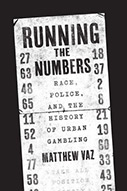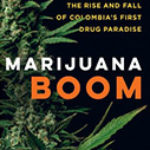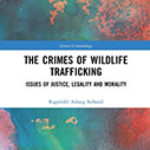Running The Numbers: Race, Police, And The History Of Urban Gambling

Author: Matthew Vaz
Publisher: Chicago: University of Chicago Press, 2020. 197p.
Reviewer: Jay Albanese | November 2020
Gambling is said to be the oldest of vices, and this book describes how it was manifested in urban America over the last century. The author’s historical focus is on its operation and impacts on the Black community in New York and Chicago, emphasizing events of the 1940s and 50s. The focus might be expanded to other economically disadvantaged communities, especially those involving recent immigrants, but the impact of numbers gambling in the Black community is well documented.
Numbers gambling is the type of gambling of primary concern in this book; this is a game where bettors pick three numbers (and could bet any amount of money, including less than one dollar). To prevent cheating, the three numbers had to match three numbers published in the newspaper later that day. Sometimes the numbers consisted of the total amount betted at the racetrack that day (the last three digits). Of course, bettors’ three-digit picks were guesses, but those guesses could win you several hundred dollars.
“Policy” gambling was a similar game that was a predecessor to numbers gambling, often based on the outcome of a spinning wheel. Numbers and policy gambling are similar in nature and used interchangeably. The reader will note the strong similarity between these forms of early gambling, which were directly imitated by contemporary legal lotteries starting in the 1970s, and now operated by governments in nearly every state.
A century ago, many of these games were managed by Black gambling figures, and the gambling was often intra-ethnic, due to the trust placed in people from your own background and community. When Prohibition ended in late 1933, the organized crime groups that had grown to provide illegal alcohol distribution turned their focus more seriously to illegal gambling as a source of revenue. This resulted in competition among illegal gambling providers, a competition that the Italian-American gangs won, given their larger, more organized gangs with greater experience in extortion and threats to control the illicit market of providers, bettors, and the ability to corrupt those public officials who might want to enforce the laws against gambling (p. 56).
The author argues that illegal gambling “was among the largest economic activities and sources of employment for African Americans in New York City’s Harlem and on the South Side of Chicago from the 1920s through the 1970s” (pp.3, 81,162). This statement is sweeping, and better sourcing would determine whether this characterization was applicable to other economically disadvantaged populations in those locations. Nevertheless, there did exist a subculture of operators, runners, bettors, and protectors that managed illegal numbers gambling within multiple US cities. Like other kinds of organized criminal activity, it was neighborhood-based, so players could deal only with people they knew and trusted, because they were also part of the same local neighborhoods.
The result of the popular numbers games for many decades, despite the laws against them, was “the basic inconsistency between the law and popular practice [which] served to undermine the legitimacy of the municipal government and its police” (p.12). When anti-gambling laws were enforced, it was necessarily arbitrary or politically-motivated, so the entire rule of law was undermined when it came to gambling enforcement. The author argues that this situation “used gambling laws to exercise authority over the black community, effectively criminalizing large segments of the black working class” (p.12).
The author goes on to claim, “gambling suppression was a principal basis for interaction between police and black neighborhoods” (p.3-4). Documentation of the comparative role of gambling enforcement to other types of police interactions would help support this point. “Gambling was a principal site of racially targeted policing during the middle decades of the twentieth century, with black gambling arrests outpacing white arrests at rates of ten to one in some cities” (p.6). This is documented later in the book, using arrest data by race for gambling offenses in several major US cities (pp.84-5).
More interesting is the transition across America from illegal gambling and its enforcement by police, to the widespread adoption of legal gambling largely via state lotteries beginning in the 1970s. In this way, gambling shifted from being a crime enforced by the state, to an accepted leisure activity operated by the state. There were economic, social, and political factors involved in this transition, but this book focuses primarily on the role of race.
The author cites sociologist Daniel Bell’s work, describing the way in which gambling was part of the “queer ladders of social mobility,” where successive ethnic groups of new immigrants climbed their way into the middle-class. Matthew Vaz takes a different perspective, arguing that the Black community actually lacked access to this ladder of social mobility.
The book contains interesting historical content. There is a good discussion of how early lotteries missed the mark because they did not permit players to choose their own numbers. Lotteries were modified to more closely resemble the numbers gambling they replaced, and thereby entice more players.
The book is organized into five chapters, plus an introduction and conclusion. Chapters 1 and 2 focus on Chicago, while the remaining chapters focus primarily on New York City, with Chapter 5 assessing the emergence of the legal lotteries in the 1960s and 1970s. The political events of the mid-20th century are emphasized, illustrating the widespread nature of illegal numbers gambling, which gradually became legal via state lotteries, following events of the 1950s and 1960s.
The author includes important recognition of the overlapping issues of urban disorder and protests, police misconduct and corruption, the rise of violent street crime, and growing intolerance for tax increases—all during the 1960s. These competing and urgent problems combined to help push gambling to the back burner of public concerns, allowing state monopolies to emerge to profit from the same games that were formerly illegal. The result was an evisceration of the illegal market, with only the most powerful and violent operators remaining.
Interesting historical context is provided regarding the influence of Virgil Peterson and the Chicago Crime Commission, and the role of the US Senate’s Kefauver Committee, in creating public recognition of the problem of illegal gambling, and its close connection to corrupt city politics and police misconduct in arbitrary gambling enforcement practices.
Also interesting is the role of Dollree Mapp, the defendant in the landmark US Supreme Court case Mapp v. Ohio (1961), which ended the arbitrary use of search and seizure by police without a warrant. Vaz provides the little-known gambling context for her original targeting by Cleveland Police (pp.93-4, 110-111). In addition, solid historical perspective is provided for the Federal Wagering Occupational Stamp Tax program (1951), which was the first (and ultimately unsuccessful) method used to “legalize” gambling by having gamblers identify their occupation for the purposes of taxation (pp.95-7, 117-118). As U.S. Senator Edwin Johnson argued in 1951, “[g]ambling may never be law enforced to death, but there is some basis for belief, it could be taxed to death” (p.99). These events combined to show that effective, non-arbitrary, non-political, gambling enforcement was impossible — laying the groundwork for gambling legalization and also providing impetus for the professionalization of police.
“In sum, a body of civil rights cohered during the 1960s, deeply connected to the abuses of the ongoing campaign to suppress gambling, both black and white” (p. 95). What is less clear is whether the gambling issue was a cause behind the civil rights movement, or whether the increased attention to arbitrary gambling enforcement was an effect of that movement.
Matthew Vaz recognizes efforts in the Black community in both Chicago and New York during the 1960s to establish legal lotteries that were under local control, in order to maintain the employment of those who had previously worked in numbers gambling. But state control of lotteries emerged for the same reasons it occurred for drug control efforts: the fear of organized crime infiltration and corruption (p.163). The last sentence in the book ends speculatively, “[l]ottery expansion turned criminals into customers, substituted humans with machines, swapped low corruption for high corruption, and changed occasional winning for endless losing” (p. 164). The author is referring to the legalization of numbers gambling, arguing that the state games have moved corruption from the local level to the state level, and made the odds of winning exceedingly small — only to attract more participants.
Jay Albanese, Wilder School of Government & Public Affairs, Virginia Commonwealth University


